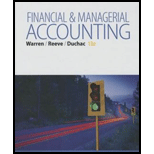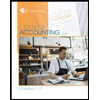
(a)
Accounts receivable turnover is a liquidity measure of accounts receivable in times, which is calculated by dividing the sales by the average amount of net accounts receivables. In other words, average receivable turnover ratio identifies the number of times the average amount of accounts receivables being collected during a particular period.
Days’ sales in receivables:
Days’ sales in receivables indicate the number of days taken by a business, to collect its outstanding amount of accounts receivable on an average. It is otherwise known as average collection period.
To calculate: Company R’s accounts receivable turnover ratio for 2016 and 2015.
(b)
To calculate: Company R’s days’ sales in receivables for 2016 and 2015.
(c)
To identify: Whether the change in accounts receivable turnover and the day’s sales in receivables from 2015 to 2016 are favorable or unfavorable.
Want to see the full answer?
Check out a sample textbook solution
Chapter 8 Solutions
Bundle: Financial & Managerial Accounting, 13th + CengageNOWv2, 2 terms (12 months) Printed Access Card
- Please provide the accurate answer to this general accounting problem using valid techniques.arrow_forwardDuring June, the production department of a process operations system completed and transferred to finished goods a total of 82,000 units of product. At the end of May, 18,000 additional units were in process in the production department and were 70% complete with respect to materials. The beginning inventory included a materials cost of $92,400 and the production department incurred a direct materials cost of $276,800 during June. Compute the direct materials cost per equivalent unit for the department using the weighted-average method.arrow_forwardMistral Inc. reported $85,000 in net profit for the year using absorption costing. The company had no units in beginning inventory, planned and actual production was24,000 units and sales were 20,500 units during the year. Variable manufacturing costs were $25 per unit and total budgeted fixed manufacturing overhead was $120,000. There was no underapplied or overapplied overhead reported during the year. Determine the net profit under variable costing.arrow_forward
 Managerial Accounting: The Cornerstone of Busines...AccountingISBN:9781337115773Author:Maryanne M. Mowen, Don R. Hansen, Dan L. HeitgerPublisher:Cengage LearningPrinciples of Accounting Volume 1AccountingISBN:9781947172685Author:OpenStaxPublisher:OpenStax College
Managerial Accounting: The Cornerstone of Busines...AccountingISBN:9781337115773Author:Maryanne M. Mowen, Don R. Hansen, Dan L. HeitgerPublisher:Cengage LearningPrinciples of Accounting Volume 1AccountingISBN:9781947172685Author:OpenStaxPublisher:OpenStax College Managerial AccountingAccountingISBN:9781337912020Author:Carl Warren, Ph.d. Cma William B. TaylerPublisher:South-Western College Pub
Managerial AccountingAccountingISBN:9781337912020Author:Carl Warren, Ph.d. Cma William B. TaylerPublisher:South-Western College Pub College Accounting, Chapters 1-27AccountingISBN:9781337794756Author:HEINTZ, James A.Publisher:Cengage Learning,
College Accounting, Chapters 1-27AccountingISBN:9781337794756Author:HEINTZ, James A.Publisher:Cengage Learning, College Accounting, Chapters 1-27 (New in Account...AccountingISBN:9781305666160Author:James A. Heintz, Robert W. ParryPublisher:Cengage Learning
College Accounting, Chapters 1-27 (New in Account...AccountingISBN:9781305666160Author:James A. Heintz, Robert W. ParryPublisher:Cengage Learning Survey of Accounting (Accounting I)AccountingISBN:9781305961883Author:Carl WarrenPublisher:Cengage Learning
Survey of Accounting (Accounting I)AccountingISBN:9781305961883Author:Carl WarrenPublisher:Cengage Learning





